| Pages:
1
..
5
6
7
8
9
10 |
aga
Forum Drunkard
    
Posts: 7030
Registered: 25-3-2014
Member Is Offline
|
|
Quote: Originally posted by unionised  | | ... trying to measure the "resistance" of a carbon foam ... by stabbing the two probes from an ohm meter into it just isn't going to work properly.
|
Agreed, but's it's fun to see low resistances on a bit of bread by any method.
The Bimbo bread pyrolysis method reliably gets lower readings no matter where the probes are prodded : 200 ~ 400 ohms rather than several kilo-ohms
with pyrolysed wood.
To lower the resistance, today i tried to coat a bit of pyrolysed bread with chemically-made copper powder and then zap it with a focussed beam of
sunlight (fresnel lens). Made absolutely no perceivable difference.
Then i wondered if copper would electro-plate onto it. After wondering for 0.6 seconds, i tried it.
Saturated copper sulphate solution with a few drops of sulphuric acid in a 250ml disposable plastic cup, 1.5V AA battery, bit of 15mm copper pipe. (i
spilt the blue contents setting up for the photo)
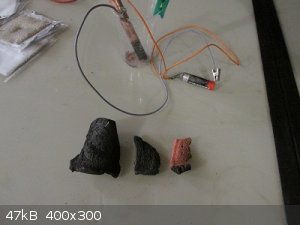
The piece of pyrolysed bread had an aligator clip<sup>1</sup> on it, making sure that the clip did not touch the solution. The current was
26mA when first measured.
This surface was facing the copper pipe and now (unsurprisingly) measures Zero ohms at all points where the copper has adhered.
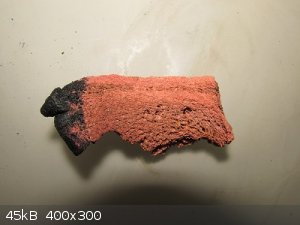
I forgot to measure the resistance of the bottom surface.
This shot shows how far through the carbon material the copper had penetrated after ~1 hour.
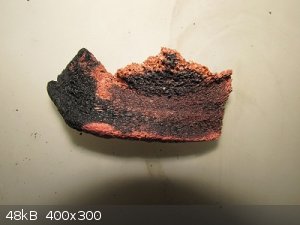
Not sure what this means/could mean.
The range of materials that can be plated is huge, so it could hold wonderful possibilites.
In terms of batteries/supercaps, maybe this could make the best current collector ever, seeing as the copper is deposited atom-by-atom making better
contact with the substrate than 'calendering' ever could.
Have to try soldering a wire to the copper plating tomorrow.
<sup>1</sup> found a bag of metal 'curtain clips' in the chinese shop. 15 for a euro.
|
|
|
aga
Forum Drunkard
    
Posts: 7030
Registered: 25-3-2014
Member Is Offline
|
|
Tried the 'press with hydraulic jack' part today with all the carbons made so far and it seems pointless.
It was a bottle jack that is commonly used for car tyre replacement and a home-built jig.
Just makes a disc of very fragile carbon that falls to bits when touched.
Maybe it needs a ton of heat while pressed to do anything different.
[Edited on 26-12-2016 by aga]
|
|
|
aga
Forum Drunkard
    
Posts: 7030
Registered: 25-3-2014
Member Is Offline
|
|
A bit of toast with a wire soldered to it.
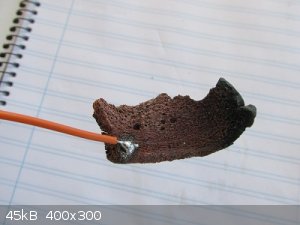
|
|
|
elementcollector1
International Hazard
    
Posts: 2684
Registered: 28-12-2011
Location: The Known Universe
Member Is Offline
Mood: Molten
|
|
Well, it's that time of the year again. Time for bread science!
Today, I decided I would try an entire furnace made out of bread. Specifically, a loaf of rosemary bread because that was the only one the local
grocery store sold that was big enough.

Size comparison with my hand:

This stuff's pretty easy to shape - I just carved out the insides with a kitchen knife. The only problem was the occasional void inside the bread,
which could be fixed by stuffing cut-out pieces into it until it regained structural integrity.
I already packed in the kanthal heating wires, which are going to be present during the bake in the oven just to make sure they have enough space.
Here's the ends poking out on opposite sides of the central chamber:

(^This one's a bit hard to see - it's the black wire in the very center of the picture.)

Probably going to bake this for 2 hours instead of 1, just because of the sheer volume of bread that needs to get carbonized. Wish me luck!
[Edited on 12-29-2016 by elementcollector1]
Elements Collected:52/87
Latest Acquired: Cl
Next in Line: Nd
|
|
|
aga
Forum Drunkard
    
Posts: 7030
Registered: 25-3-2014
Member Is Offline
|
|
The 'wire' looks like rosemary to me ...
It will not retain any absolute dimensions during pyrolysis, so just carve it up afterwards.
Such a HUGE piece will give an awesome result !
|
|
|
violet sin
International Hazard
    
Posts: 1482
Registered: 2-9-2012
Location: Daydreaming of uraninite...
Member Is Offline
Mood: Good
|
|
Aga: YES YES YES!!! You frigging soldered to your coppered bread foam!! I love this
Ec1: awesome, best of luck with form holding up through baking. Really cool to see some one use nichrome wire in the thing pre bake. After a few of
my experiments, I also wanted to do a whole loaf, but never got around to it with holiday season.
Not as fun to take a back seat and watch others do all the fun... But progress is still awesome. Thanks for keeping a guy going. I'll try to get
actual chores done so I can participate again soon
|
|
|
aga
Forum Drunkard
    
Posts: 7030
Registered: 25-3-2014
Member Is Offline
|
|
Just had a thought: that recent paper about making ethanol from carbon dioxide and a 'deposited copper on n-doped graphene nanotube spike' catalyst
might be an application of this toast thing.
Bread slices dampened with ammonia, then pyrolysed, then very briefly copper plated might work.
The resulting 'tile' will be both conductive and porous, so two of them could be used for the electrodes.
If they were arranged horizontally, like this '=' with the CO2 (or air) bubbled in from underneath, the gas will pass over a huge surface area of
'catalyst', twice !
TODO List += 'EtOH from Air and Toast'.
|
|
|
aga
Forum Drunkard
    
Posts: 7030
Registered: 25-3-2014
Member Is Offline
|
|
Seems that a steel 'form' can help get the resulting toast flatter.
Probably better to just lay the bread horizontally and put a plate of steel on top.

Certainly gets hotter in those tins than i ever imagined !
 
Edit:
Tried the horizontal steel plate.
6 circles of bread separated by a circle of steel plate with holes in it. Some big nuts on top to weigh it all down. Whole lot pyrolysed.
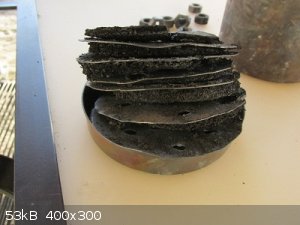  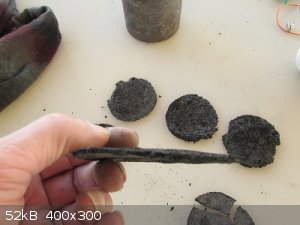 
[Edited on 1-1-2017 by aga]
|
|
|
Jstuyfzand
Hazard to Others
  
Posts: 166
Registered: 16-1-2016
Location: Netherlands
Member Is Offline
Mood: Learning, Sorta.
|
|
I wonder, what if you electrolyse the carbon in a solution of Manganese sulphate, depoisiting MnO2, and use it as a catalyst for in the Ostwald Nitric
Acid thread. A paper has been posted which showed potential.
|
|
|
aga
Forum Drunkard
    
Posts: 7030
Registered: 25-3-2014
Member Is Offline
|
|
Unfortunately this batch has come out with random point-resistances in the mega-ohm range instead of the usual few hundred ohm range, so
electrolytically depositing stuff on them won't work.
Not sure why that happened.
Far too many possible things to try with this toasted bread for 1 person to try in 1 lifetime.
Give it a go yourself and see what you get.
|
|
|
Jstuyfzand
Hazard to Others
  
Posts: 166
Registered: 16-1-2016
Location: Netherlands
Member Is Offline
Mood: Learning, Sorta.
|
|
I finally got my head out of my arse and made my foundry, first thing to throw in was a piece of bread.
Flames are spewing out so results might not be amazing but i'm one step closer to muh homemade graphite anodes, although many steps need to be taken
still.
[Edited on 3-1-2017 by Jstuyfzand]

Erm, the foil melted?
This is the first piece of toasted bread that is toasted at higher temperatures though, I wonder if this will graphitize it more increasing
conductivity.
I don't have an OhmMeter, unfortunately, but I do have a PSU which can measure current and voltage, so I can get the resistance, but if its in the
mega ohm range I'm affraid I wont see any current.
[Edited on 3-1-2017 by Jstuyfzand]
Edit:
After half an hour of toasting, I pulled out the bread which fell apart, I took a small piece to the PSU.
CONDUCTIVITY!
Arcs spawned around the piece at 10 volts, 2 -3 Amps was measured but it fluctuated alot. The structure feels very crispy but fragile, it draws
like graphite though.
I quickly submerged it into some water with NaCl, 1 amp with the tip of it submerged and very poor electrical contact from my aligator clips.
Tomorrow I will solder a wire to it and put something bigger in the furnace and test that out as an anode and the conductivity when submerged.
Looks like diy anodes are pretty close after all!
A youtube video:
https://youtu.be/DZ8PJsRpl_U
[Edited on 3-1-2017 by Jstuyfzand]

[Edited on 3-1-2017 by Jstuyfzand]
|
|
|
aga
Forum Drunkard
    
Posts: 7030
Registered: 25-3-2014
Member Is Offline
|
|
Awesome Jstuyfzand !
The sparking in the video is exactly like it does in a microwave, just it does it all over.
Soldering a wire to the pyrolysed bread requires plating it with Copper first.
1.5V AA battery, bit of copper tube connected to the +ve terminal, copper sulphate solution, bit of e-Toast connected to the -ve terminal, dunk 'em in
the solution, leave it overnight. (make sure the wire to the toast does not touch the liquid)
Super awesome that yours came out with low resistance as well.
I tried the discs thing using some ammonium sulphate crystals, and that made e-Toast with resistance in the 30+ mega-ohm range, basically an
insulator.
Get yourself a multimeter !
Gonna be a long and fun road from here on in.
Edit:
Sorry i lied about the "Not sure why that happened" thing earlier.
Having proved yourself an Actual Amateur Chemist i'll not withold data from you again.
[Edited on 3-1-2017 by aga]
|
|
|
Jstuyfzand
Hazard to Others
  
Posts: 166
Registered: 16-1-2016
Location: Netherlands
Member Is Offline
Mood: Learning, Sorta.
|
|
I have some copper acetate laying around so I can start plating first thing tomorrow, I will plate a small part on the top to solder a wire to it and
then test it for electrolysis.
I am experimenting to get some anodes for Hydrogen production and chlor alkali, however, there are mixed interests in this thread.
Is there anything you would like me to try with this conductive toast?
Please do realize that my supply of reagents is depressing, but I if you suggest something I'll gladly find a way.
aga, don't worry about it, just keep throwing pieces of bread into fire!
I used a piece of baguette by the way, it shrinked to 25% of its original volume, tomorrow I am pyrolizing a different kind of bread, I hope the
results won't change too much.
|
|
|
Jstuyfzand
Hazard to Others
  
Posts: 166
Registered: 16-1-2016
Location: Netherlands
Member Is Offline
Mood: Learning, Sorta.
|
|
The second piece came out conductive as well, with a very sturdy structure.
It was a very weird shape though, and plating was inconsistent.
I will try carbonizing the square white wonderbread type, I hope it will form something flat like sheets, so that the plating process is easier.
I will also try bread dough, I`ll leave it in longer and see if I get something resembling a graphite rod.
|
|
|
aga
Forum Drunkard
    
Posts: 7030
Registered: 25-3-2014
Member Is Offline
|
|
The bread tends to curl.
Stick some steel on top to hold it in shape.
Getting a Shape has proved to be hard with this process.
|
|
|
elementcollector1
International Hazard
    
Posts: 2684
Registered: 28-12-2011
Location: The Known Universe
Member Is Offline
Mood: Molten
|
|
Just a thought, has anyone tried making carbon pancakes? Seems like they'd be better than regular bread in terms of pore size distribution and
mechanical properties. Might also make a good ceramic heating plate.
Elements Collected:52/87
Latest Acquired: Cl
Next in Line: Nd
|
|
|
gatosgr
Hazard to Others
  
Posts: 237
Registered: 7-4-2015
Member Is Offline
Mood: No Mood
|
|
That's just yummy I suddendly have an appetite for donuts, there is another research that used the maillard reaction to make carbon foam but it didn't
use dough, I remember it used NH4Cl to make ammonia bubbles. Nitrogenous compounds emit toxic stuff when pyrolyzed, take care.
[Edited on 18-1-2017 by gatosgr]
|
|
|
elementcollector1
International Hazard
    
Posts: 2684
Registered: 28-12-2011
Location: The Known Universe
Member Is Offline
Mood: Molten
|
|
Just tried the Bread Furnace again - this time, with homemade bread!
Recipe was doubled from this source, with regular flour substituting for rye flour:
http://www.foodnetwork.com/recipes/emeril-lagasse/homemade-r...
Results of 1.5 hours of baking at 500 F, next to a 1000 mL beaker for scale. Apologies for the horrible pic, I really need a camera that's not my
phone.

Here's a closeup of the kanthal wires inside the furnace.

Does anyone have any ideas about insulating these from the metal crucible? Maybe more breadmix in between? I'm just worried about space - the crucible
I intend to use is pretty wide, and I misjudged the size of the cavity in the center - the bread expanded while baking and shrank it. : /
[Edited on 1-22-2017 by elementcollector1]
Elements Collected:52/87
Latest Acquired: Cl
Next in Line: Nd
|
|
|
elementcollector1
International Hazard
    
Posts: 2684
Registered: 28-12-2011
Location: The Known Universe
Member Is Offline
Mood: Molten
|
|
Have since made a mix of flour and water, and coated the kanthal wires with it before baking the whole thing. I had to widen the cavity inside the
main furnace block to fit everything in, but now all the wires are electrically insulated. As soon as I receive my stainless steel reactor again, I'm
going to bake the inner insulation until it burns to carbon. Hopefully that way this furnace won't light on fire when I power it. : /
Elements Collected:52/87
Latest Acquired: Cl
Next in Line: Nd
|
|
|
aga
Forum Drunkard
    
Posts: 7030
Registered: 25-3-2014
Member Is Offline
|
|
Cool ! Looks like a Huge chunk of carbon material there.
There's a Huge chunk of carbon material somewhere around that might be cut up and used as a hi-temp insulator 
(alternatively, rock wool insulation)
Edit:
A while ago i tried mixing a type of building plaster with sand to make a pourable insulation material for a home-made heating mantle.
It worked as far as the pouring-on-the-coiled-wire-and- setting-hard part went, but smoked horribly when i tried to heat it with the kanthal wire to
dry it - eventually it broke to bits.
Maybe heating it that was was silly, possibly i just used the wrong material. Maybe a high-sand cement mix would work better.
[Edited on 24-1-2017 by aga]
|
|
|
wg48
National Hazard
   
Posts: 821
Registered: 21-11-2015
Member Is Offline
Mood: No Mood
|
|
Here is some carbon foam made from a malt loaf when I defrosted it in a microwave oven accidentally on full power. A malt loaf is probably very
similar to bread but with a lot of sugar. It held its shape and does appear to be well carbonised. Its crispy and has a glass like sound when tapped
though it reads open circuit even on the 20mohm range of a multimeter.
Be warned it produced an acrid smoke that stung my eyes and throat. It took a more than an hour to clean the microwave oven and it along with the
kitchen and half the house still smell like a wood fire.

|
|
|
aga
Forum Drunkard
    
Posts: 7030
Registered: 25-3-2014
Member Is Offline
|
|
Shame it came out high-resistance.
Mixing in zinc nitrate before baking might have worked, but i wouldn't suggest repeating the microwave experiment in the house !
|
|
|
Jstuyfzand
Hazard to Others
  
Posts: 166
Registered: 16-1-2016
Location: Netherlands
Member Is Offline
Mood: Learning, Sorta.
|
|
Got the bloody kiln working, but the damn bread caught on fire and now there is soot on my ytong "refractory".
Got a multimeter, results in an hour or so.
The piece of bread is a custom baked slab of hard bread resembling a plate, to continue with my ongoing search for a cheaper alternative to SS for
Hydrogen production and consumable carbon/graphite electrodes. Which is also the reason I cant mix in chemicals like zinc nitrate.
PS: When making your own kiln, make it square. This pentagon thing looks good on paper but making the angles with a handsaw is a pain in the bum.
25$ got me pretty far though (excluding pid)
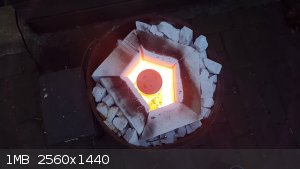
[Edited on 30-4-2017 by Jstuyfzand]
|
|
|
Jstuyfzand
Hazard to Others
  
Posts: 166
Registered: 16-1-2016
Location: Netherlands
Member Is Offline
Mood: Learning, Sorta.
|
|
7 ohms per centimetre, damn.
Brittle though! I think it was in too long.
|
|
|
ferrousexplosive
Harmless

Posts: 7
Registered: 3-7-2017
Member Is Offline
Mood: No Mood
|
|
is it suitable for electrolysis?
|
|
|
| Pages:
1
..
5
6
7
8
9
10 |